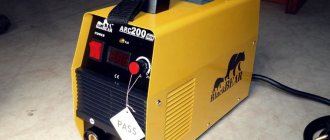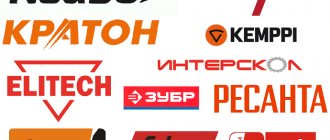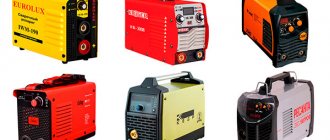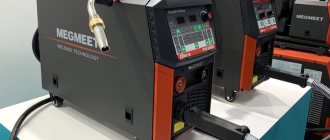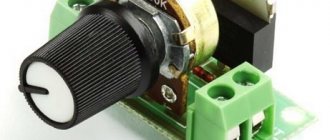One of the fusion methods is resistance spot welding. Its essence lies in tightly connecting two parts at a certain point and passing electric current through the point of contact.
Spot resistance welding machines are in demand in many industries. For everyday use, they learned to make them with their own hands, using transformers or a system of capacitors.
Process phases
Three phases can be distinguished in the spot welding process. In the first phase, compression of the workpieces occurs, which leads to plastic deformation at the point of contact. For this purpose, the resistance welding machine is equipped with special pliers or other similar devices.
In the second phase, current is supplied to the contact area, which causes the metal to melt at the connection point and form a molten core. While the current passes, the core expands to its maximum. The compression of the joined products causes the appearance of a dense belt around the liquid core, which prevents the spreading of the molten metal.
In the third phase, the welding current is turned off, the metal cools and crystallizes. To relieve stress during cooling, the clamping force is maintained for some time.
The requirements for welded joints are determined by the state standard - GOST 15878-79. About. What electrodes can be used in a resistance spot welding machine are described in GOST 14111-90. They are made from copper or bronze alloyed with chromium, cadmium, zirconium.
Types of equipment
When resistance spot welding, the machine can produce current of different types and frequencies. Based on these distinctive features, welding equipment is divided into four classes:
- resistance spot welding on alternating current;
- low-frequency resistance welding;
- capacitor type devices;
- DC welding.
There are multi-point resistance welding machines for welding meshes in production. In such devices, welding occurs simultaneously at several points. Any equipment has its advantages, but single-point AC devices have become the most popular.
How spot welding works
This type of welding has characteristic features that must be taken into account when operating the equipment. When current is passed through electrodes through overlap welded metal structures, heat is generated, which rapidly heats and melts the parts.
The metal parts are pressed tightly with the electrode wire, due to which they are tightly connected to each other.
AC operation
A resistance welding machine operating on alternating current is a transformer with two electrodes in the secondary winding. Copper is used as a material for resistance spot welding electrodes. Parts are placed between the electrodes and pressed against each other using a special device.
In the primary winding there is a thyristor module, through which the supply voltage of 220 V or 380 V is supplied to the winding. By applying a control signal to the thyristor, you can obtain the required current duration for resistance spot welding. By changing the opening angle of the thyristor, you can adjust the shape of the signal that arrives at the secondary winding.
In the case of using several primary windings, a set of transformation ratios can be obtained by combining their connection. As a result, several levels of voltage and current are obtained in the secondary winding. This allows the resistance spot welding machine to operate in different modes.
To control the equipment, there is an additional unit that has a relay, a control panel and a controller circuit.
Equipment on capacitors
A resistance spot welding machine may consist of a capacitor charging unit, a large battery of capacitors, a control unit and electrodes with a workpiece clamping mechanism.
The principle of contact welding lies in the initial rather long accumulation of electrical energy on the plates of capacitors and its instant release when creating an artificial short circuit through the point of contact.
The ability to accumulate charge in a capacitive battery allows the use of equipment of lower power compared to other welding machines.
Due to the constant battery capacity, a normalized energy release per welding pulse is obtained, which allows you to obtain a stable result regardless of changes in the mains voltage and other network characteristics.
Capacitor resistance welding lasts for milliseconds, resulting in a powerful release of energy in a small contact area. This allows it to be used when welding alloys with high thermal conductivity such as copper, as well as metals with different thermal characteristics.
Capacitor resistance spot welding machines with a rigid characteristic and fast discharge are widely used in radio electronics and instrument making.
When calculating the required energy for welding a particular joint, you can use the formula:
W = C*U2/2,
where C is the capacity in farads, W is the energy in watts; U is the charging voltage in volts. By including an active variable resistance in the charging circuit, you can regulate the amount of charging current, charging time and power consumption.
Additional options
If the device performs regular, long-term work, the presence of a cooling system should be taken into account. Devices with water cooling and a radiator last much longer than their counterparts without cooling.
For full operation, the spotter requires a gun and a reverse hammer. Also, all welding machines require copper electrodes as consumables. If the equipment weighs more than 13 kg, then it should purchase a trolley for easy transportation on wheels.
Where is the method used?
A feature of resistance spot welding is a brief impact on the products being joined (from a few milliseconds to several seconds), a welding current of several thousand amperes and a voltage of 1 to 2-3 volts. In this case, a force at the welding point is required from tens to hundreds of kilograms. A small contact area leads to a small area of metal melting.
Thanks to these features, spot welding is used when welding metals with a thickness of a few microns to 20-30 mm. These capabilities have ensured its use in radio electronics, instrument manufacturing, the aviation and automotive industries, construction and many other industries.
It is impossible to imagine auto repair shops without resistance spot welding machines. They are indispensable when removing dents. All cars and airplanes are created using resistance welding. Almost all lithium batteries in laptops are connected using single-sided resistance spot welding.
Voltage
Welding installations are powered by 220V and 380V. This is indicated in the documents included with the welding machine.
Important! It is not recommended to connect devices with a power of more than 5 kW to a household network.
Pros and cons of technology
The technology has become widespread due to the simplicity and ease of use of welding equipment and high productivity. The device can provide several hundred welds per minute with low energy consumption, and does not emit any harmful substances into the atmosphere.
The technology is easy to automate. Welding does not require welding wire, additives or fluxes. The connection is strong and without residual deformations.
The only drawback is the leaky connection of the products. The device operates intermittently, making connections at individual points, so we are not talking about tightness.
Welding methods
There are several methods for spot welding:
Spot - welding of elements occurs in one or many places. It is used in instrument making, the automotive industry, and the construction of sea, river and aircraft vessels.
Provides welding of steel sheets up to twenty millimeters thick.
Relief method - structural elements are welded in one or several prepared places. The difference between this method and the previous one is due to the shape of the fastened elements at the welding site.
Seam method - the welded elements are fastened with a series of welding seams. A seam can consist of individual weld pixels or overlapping ones. Used for the manufacture of various tanks requiring a high degree of tightness.
How to assemble a simple welding machine at home: drawings of inverter models and step-by-step assembly instructionsDo-it-yourself welding table - step-by-step instructions for manufacturing and assembly (65 photos)
What types of welding machines are there: types, principles of operation and classification of devices
Docking - elements are welded along the adjacent contact area under high temperature. They are used in laying pipelines and making anchor chains for ships.
Possible defects
In spot welding, the strength of the joint is such that fractures occur in the base metal, since the weld spots are thick. Welding time and clamping force are critical. If you calculate them incorrectly, the device will cook with defects.
There are three main types of defects:
- deviations of the cast zone from the optimum, its displacement from the point of contact;
- incomplete penetration at the point of contact:
- change in the physical and chemical properties of the metal at the welding point.
The most dangerous thing is the lack of a cast area. Thermal bonding occurs, in which the connection can withstand minor loads. Under variable loads and temperature changes, the connection breaks.
Strength is compromised by high pressure on the electrodes of the resistance welding machine, which causes dents. Strength is also weakened by metal splashes.
